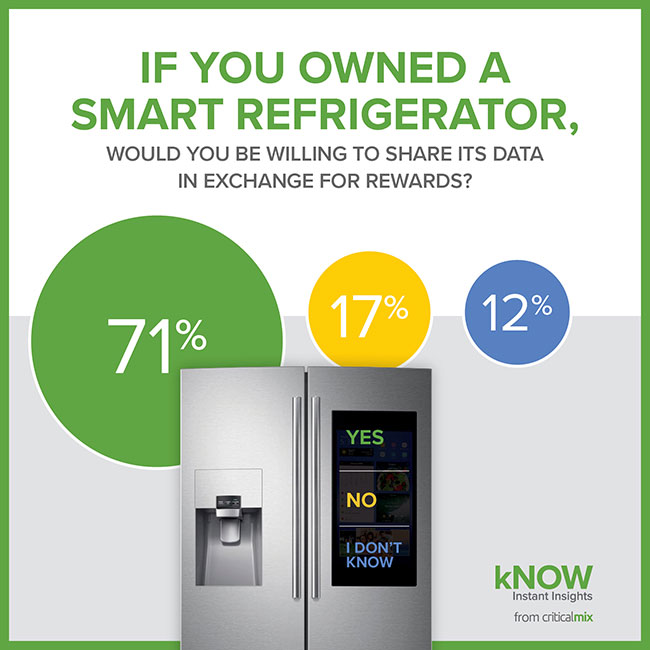SPONSORED CONTENT
Is the Internet of Things the solution researchers have been waiting for?
Hugh Davis
Co-CEO, Critical Mix
 Before taking action to solve the survey experience dilemma, it is crucial to understand the Internet of Things (IoT). To put it simply, IoT is when a consumer’s devices can communicate with one another to send and receive data. IoT takes Internet connectivity beyond traditional smart devices like computers, tablets and smartphones. It extends these capabilities to devices traditionally considered “dumb,” such as one’s refrigerator, coffee maker and washing machine. Tiny embedded sensors will transform all devices into active participants in this data exchange.
Before taking action to solve the survey experience dilemma, it is crucial to understand the Internet of Things (IoT). To put it simply, IoT is when a consumer’s devices can communicate with one another to send and receive data. IoT takes Internet connectivity beyond traditional smart devices like computers, tablets and smartphones. It extends these capabilities to devices traditionally considered “dumb,” such as one’s refrigerator, coffee maker and washing machine. Tiny embedded sensors will transform all devices into active participants in this data exchange.
As a consumer, you may be thinking, “Why would I need my coffee maker to be a smart device?” Well, imagine this: Your city is experiencing unexpected inclement weather and your standard 25-minute commute will now take 50 minutes. Before you even wake up, your smart alarm clock has checked traffic, cross-referenced your calendar and is set to wake you up 30 minutes early after recognizing that you have a 9 a.m. client meeting. While being punctual is important, so is waking up to a hot cup of coffee. So in addition to waking you up earlier, your alarm clock has notified your coffee maker to prepare your usual cup of coffee 30 minutes early. Thanks to this exchange of information, you will be on time for your meeting and have coffee in-hand the moment you wake up. Interconnectivity among devices enables you to start each day on the right foot, regardless of circumstances beyond your control.
Imagine you just finished a load of laundry and find that your favorite sweater shrunk from a large to a small. Well, what if each of your clothing items contained a sensor that could inform your washing machine exactly what each load contained? Your washing machine would perform the perfect cycle every time. Perhaps you accidentally placed a red shirt and white pants in the same load. Your smart washing machine would recognize that performing the cycle as is will result in a lovely but unsolicited shade of pink. To save you from this first-world disaster, your machine will refuse to start and notify you exactly why.
As devices communicate with each other, the consumer benefits are endless. Refrigerators taking inventory will ensure that you never run out of ketchup, your thermostat will always be set to the optimal temperature, your car will let you know when the line at Starbucks is short and place your order in minutes.
As IoT develops, we will see these types of conveniences emerge more frequently. The applications of IoT in home automation, elder care, medical care, productivity and energy management are endless but personally, I am most excited for its impacts on survey research.
Currently, we face several challenges in survey research:
- Surveys are too long and only getting longer.
- People don’t want to take surveys.
- Survey response bias skews data.
To combat these challenges, I ask, “Do I have permission to speak to your refrigerator?”
Leveraging Critical Mix’s kNOW Instant Insights survey product, we asked a nationally representative sample of 1,000 U.S. adults the following question, “Assuming proper measures were taken to protect your privacy, if you owned a smart refrigerator that could keep inventory of the products you purchased, would you share this data in exchange for rewards?”  Seventy-one percent of survey members said yes.
Seventy-one percent of survey members said yes.
Survey members who permit researchers to communicate with their smart devices will still be incentivized for participation but now without the hassle of a 20-minute questionnaire. By minimizing the legwork required by respondents, survey research will see a surge in participation. Additionally, market researchers will gain access to immediate, accurate data, free of survey bias. IoT will transform survey-taking and distribution processes, leading to a new age of survey research in which the experience is effortless and the data is precise.
For years, market researchers have actively tried to improve upon the issue of survey length. The challenge is striking a balance between a respondent’s survey-taking experience and your survey’s ability to acquire the necessary data. As a researcher, while it is crucial to develop a survey that answers all your questions, it is equally important to ensure that it does not appear daunting. By facilitating data collection directly from smart devices, IoT will enable researchers to shorten and fundamentally eliminate tedious surveys. Once respondents grant permission to extract the data, their work is done.
By communicating with a consumer’s home devices, researchers will be able to uncover answers without speaking directly with the consumer. The issue of over-asking survey questions will be nonexistent. As these innovations take shape, we will no longer require 20 to 30 minutes of a respondent’s time and survey-taking will not be considered a laborious task.
By simplifying the survey-taking process, more consumers will feel inclined to participate in market research. Increased survey participation will lead to a larger pool of respondents, garnering more extensive and holistic data. The effort required for survey completion will shift from survey members to smart devices, further promoting participation.
IoT will serve as a transformative gateway to rich, accurate and immediate data, free of survey bias. Incorrect survey responses occur for several reasons, including a respondent’s embarrassment, lack of knowledge, human error and rushing to complete a survey. IoT would eliminate these issues by authorizing researchers to communicate with devices designed to collect and report accurate data. We would gain access to a larger, more comprehensive data set and, in turn, better predict and analyze consumer behavior. Additionally, the transfer of data from these devices would be quick and seamless. After data collection, researchers could dive into developing insights and bypass the wait for survey members to complete questionnaires.
While we still have a way to go with technological developments and privacy concerns, IoT has the potential to make this vision a reality. The result of applying IoT to market research is a better experience for respondents and higher-quality data for researchers. IoT might just be the key to finally revamping the survey-taking process, increasing survey participation and enhancing data accuracy.

www.criticalmix.com
simplify@criticalmix.com
800-651-8240
